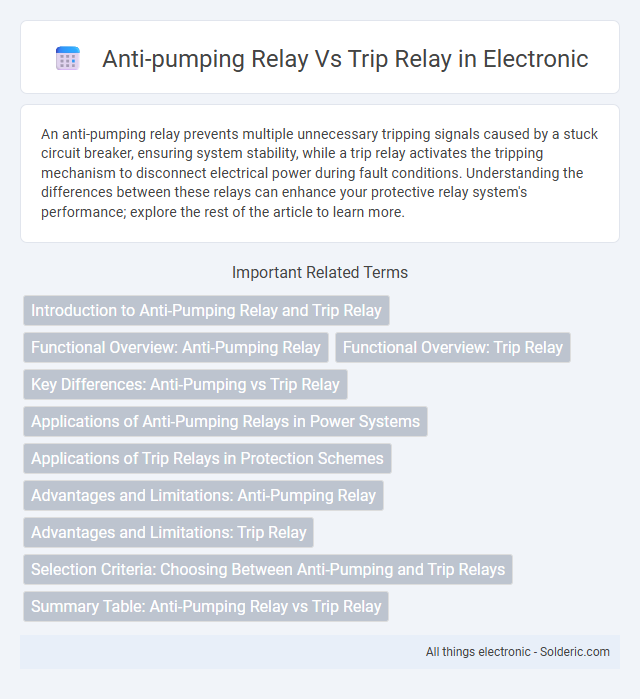An anti-pumping relay prevents multiple unnecessary tripping signals caused by a stuck circuit breaker, ensuring system stability, while a trip relay activates the tripping mechanism to disconnect electrical power during fault conditions. Understanding the differences between these relays can enhance your protective relay system's performance; explore the rest of the article to learn more.
Comparison Table
| Feature | Anti-Pumping Relay | Trip Relay |
|---|---|---|
| Primary Function | Prevents repeated tripping by blocking multiple close commands | Initiates circuit breaker operation to disconnect faulty circuit |
| Application | Used in motor protection and circuit breaker control to avoid contact wear | Used in protection schemes to isolate faults and prevent damage |
| Operation | Blocks successive close signals within a preset time window | Activates breaker trip coil instantly upon fault detection |
| Impact on System | Enhances relay and breaker longevity by preventing unnecessary operations | Protects electrical equipment by isolating fault conditions |
| Typical Use Case | To avoid relay chatter and equipment damage during auto-reclosing | To disconnect faulty equipment to maintain system safety |
| Control Signal | Receives close commands and controls blocking logic | Receives fault signals and actuates trip coil |
Introduction to Anti-Pumping Relay and Trip Relay
Anti-pumping relays prevent repeated closing of circuit breakers by blocking additional closing signals, enhancing protection system stability and preventing equipment damage. Trip relays, on the other hand, initiate the disconnection of electrical circuits during fault conditions to isolate and protect electrical equipment from harm. Both devices are critical components in protection schemes, ensuring operational safety and reliability in power systems.
Functional Overview: Anti-Pumping Relay
The anti-pumping relay prevents repeated tripping of circuit breakers caused by continuous or oscillating fault signals, ensuring system stability. It functions by blocking the reactivation of the trip coil once a fault is cleared until a manual reset occurs. This relay is essential in protecting electrical systems from nuisance trips and maintaining reliable operation in power distribution networks.
Functional Overview: Trip Relay
A trip relay functions as a protective device in electrical systems, designed to disconnect power by triggering circuit breakers during fault conditions to prevent damage. It monitors signals such as overcurrent, voltage anomalies, or short circuits and initiates an immediate shutdown to safeguard equipment and enhance safety. Understanding your trip relay's role ensures timely fault detection and effective system protection.
Key Differences: Anti-Pumping vs Trip Relay
Anti-pumping relays prevent multiple unintended circuit breaker operations by inhibiting repetitive closing signals, while trip relays initiate the breaker trip function to disconnect faulty circuits. The anti-pumping relay enhances system stability by blocking continuous closure commands, in contrast to trip relays which respond to fault conditions by triggering breaker opening. Understanding these distinct roles is essential for designing reliable electrical protection systems and ensuring safe fault isolation.
Applications of Anti-Pumping Relays in Power Systems
Anti-pumping relays are primarily used in power systems to prevent repeated tripping and closing of circuit breakers caused by relay malfunctions or faults, thereby enhancing system stability. These relays inhibit the breaker from reclosing immediately after a trip signal, reducing mechanical wear and minimizing system disturbances. Their application is crucial in protecting transformers, generators, and transmission lines by maintaining controlled breaker operations during fault conditions.
Applications of Trip Relays in Protection Schemes
Trip relays play a crucial role in electrical protection schemes by instantly disconnecting faulty circuits to prevent equipment damage and maintain system stability. They are commonly applied in overcurrent, earth fault, and differential protection to isolate and safeguard power systems from abnormal conditions. Your power system's reliability greatly benefits from trip relays by minimizing outage time and ensuring swift fault clearance.
Advantages and Limitations: Anti-Pumping Relay
Anti-pumping relays prevent repeated tripping signals, reducing the risk of equipment damage due to continuous relay operation, which enhances system stability and prolongs the lifespan of your protection devices. However, they may introduce delayed fault clearance because of their intentional time delay, potentially affecting response speed in critical fault conditions. Their primary advantage lies in reducing nuisance trips, but this comes at the limitation of slower reaction times compared to trip relays, which act immediately to isolate faults.
Advantages and Limitations: Trip Relay
Trip relays provide rapid fault isolation by instantly disconnecting electrical circuits, minimizing equipment damage and enhancing safety. Their primary limitation involves potential nuisance trips caused by transient faults, which may lead to unnecessary downtime and operational interruptions. You can optimize system reliability by carefully selecting trip relay settings to balance sensitivity and stability.
Selection Criteria: Choosing Between Anti-Pumping and Trip Relays
Selecting between anti-pumping and trip relays depends on the specific protection needs of electrical systems and operational requirements. Anti-pumping relays prevent repetitive tripping signals during circuit breaker closing operations by inhibiting re-closure attempts, ensuring system stability and reducing mechanical wear. Trip relays, designed to initiate breaker trips upon fault detection, are essential for immediate disconnection of faulty circuits, with priority given to fault sensitivity, response time, and coordination with other protective devices influencing the choice.
Summary Table: Anti-Pumping Relay vs Trip Relay
An anti-pumping relay prevents repeated closing commands to avoid equipment damage, commonly used in circuit breakers to ensure stability by blocking rapid reclosing attempts. A trip relay activates the disconnection of power during fault conditions, playing a critical role in protecting electrical circuits from overloads or short circuits. Your system benefits from understanding this distinction, as anti-pumping relays maintain operational safety during switching, while trip relays provide immediate fault isolation.
anti-pumping relay vs trip relay Infographic

 solderic.com
solderic.com